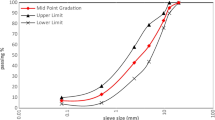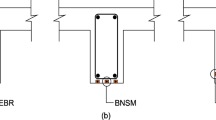Abstract
In the last years, RILEM Technical Committee 237-SIB proposed a new test protocol for reclaimed asphalt pavement (RAP) characterization, the cohesion test, with the goal to facilitate the identification of the most suitable solution for the recycling within new pavement layers. However, this procedure actually allows discriminating between different RAP sources but it does not exactly indicate the effective “activity” of the binder in the RAP. The present paper deals with the analysis of different RAP materials through the RILEM cohesion test. In particular, two “young” RAPs, different in composition and milled immediately after being laid, were aged in the laboratory and tested at different ageing levels. Moreover, an in-site aged RAP was tested as reference, either in neat conditions or after being sprayed with a rejuvenator. The results showed that the actual cohesion test approach, based on the evaluation of the indirect tensile strength (ITS), is not able to distinguish between RAP binders with stiff-brittle behaviour or good residual binding properties (despite the first is an unwanted condition while the second is a desired condition, both of them determine an increase in ITS). Differently, the Cracking Tolerance Index (\({\rm{CT}}_{\rm{Index}}\)) defined by ASTM D8225-19 can emphasize the RAP bitumen ductility and highlight any residual binding and adhesive properties. For this reason, a RILEM cohesion test improvement is proposed by including the \({\rm{CT}}_{\rm{Index}}\) calculation in the analysis.











Similar content being viewed by others
References
Fang X, Garcia A, Winnefeld F, Partl MN, Lura P (2015) Impact of rapid-hardening cements on mechanical properties of cement bitumen emulsion asphalt. Mater Struct 49:487–499
Xu G, Ma T, Fang Z, Huang X, Zhang W (2019) The evaluation method of particle clustering phenomena in RAP. Appl Sci 9:424–439
Pahlavan F, Samieadel A, Deng S, Fini E (2019) Exploiting synergistic effects of intermolecular interactions to synthesize hybrid rejuvenators to revitalize aged asphalt. ACS Sustain Chem Eng 7:18
Lesueur D (2009) The colloidal structure of bitumen: consequences on the rheology and on the mechanisms of bitumen modification. Adv Colloid Interface Sci 145:42–82
Mazzoni G, Bocci E, Canestrari F (2018) Influence of rejuvenators on bitumen ageing in hot recycled asphalt mixtures. J Traffic Transport Eng (Engl Vers) 5(3):157–168
Hung AM, Fini EH (2019) Absorption spectroscopy to determine the extent and mechanisms of aging in bitumen and asphaltenes. Fuel 242:408–415
Ongel A, Hugener M (2015) Impact of rejuvenators on aging properties of bitumen. Constr Build Mater 94:467–474
Miró R, Martínez AH, Moreno-Navarro F, Rubio-Gámez M (2015) Effect of ageing and temperature on the fatigue behaviour of bitumens. Mater Des 86:129–137
Grilli A, Cardone F, Bocci E (2018) Mechanical behavior of cement-bitumen treated materials containing different amounts of reclaimed asphalt. Eur J Environ Civ Eng 22(7):836–851
Wang Y, Leng Z, Li X, Hu C (2018) Cold recycling of reclaimed asphalt pavement towards improved engineering performance. J Clean Prod 171:1031–1038
Grilli A, Graziani A, Bocci E, Bocci M (2016) Volumetric properties and influence of water content on the compactability of cold recycled mixtures. Mater Struct 49(10):4349–4362
Graziani A, Godenzoni C, Cardone F, Bocci E, Bocci M (2017) An application of the michaelis-menten model to analyse the curing process of cold-recycled bituminous mixtures. Int J Pavement Res Technol 10:64–74
Xiao F, Yao S, Wang J, Li X, Amirkhanian S (2018) A literature review on cold recycling technology of asphalt pavement. Constr Build Mater 180:579–604
de la Roche C, Van de Ven M, Planche JP, Van den Bergh W, Grenfell J, Gabet T, Mouillet V, Porot L, Farcas F, Ruot C (2013) Hot recycling of bituminous mixtures. In: Partl MN, Bahia HU, Canestrari F, de la Roche C, Di Benedetto H, Piber H, Sybilski D (eds) Advances in interlaboratory testing and evaluation of bituminous materials, RILEM State-of-the-Art Reports, vol 7, pp 361–428
Bocci E, Mazzoni G, Canestrari F (2019) Ageing of rejuvenated bitumen in hot recycled bituminous mixtures: influence of bitumen origin and additive type. Road Mater Pavement 20:S127–S148
Ashtiani MZ, Mogawer WS, Austerman AJ (2018) A mechanical approach to quantify blending of aged binder from recycled materials in new hot mix asphalt mixtures. Transport Res Rec 2672(28):107–118
Yadava AK, Ahmad SA (2019) A critical review of characterization and performance evaluation of reclaimed asphalt pavement (RAP) in road construction. Int J Civ Eng Tech 10(1):1379–1389
Khosla P, Ramoju SS (2017) Characterization of different RAP sources. Technical Report FHWA/NC/2014-05, North Carolina Department of Transportation
Preti F, Silva Gouveia BC, Rahmanbeiki A, Romeo E, Carter A, Tebaldi G (2019) Application and validation of the cohesion test to characterise reclaimed asphalt pavement. Road Mater Pavement 20(S1):434–445
Tebaldi G, Dave E, Cannone Falchetto A, Hugener M, Perraton D, Grilli A, Lo Presti D, Pasetto M, Loizos A, Jenkins K, Apeagyei A, Grenfell J, Bocci M (2018) Recommendation of RILEM TC237-SIB: protocol for characterization of recycled asphalt (RA) materials for pavement applications. Mater Struct 51:142
Tebaldi G, Dave E, Cannone Falchetto A, Hugener M, Perraton D, Lo Presti D, Pasetto M, Loizos A, Jenkins K, Apeagyei A, Grenfell J, Bocci M (2019) Recommendation of RILEM TC237-SIB on fragmentation test of recycled asphalt. Mater Struct 52:82
Tebaldi G, Dave E, Cannone Falchetto A, Hugener M, Perraton D, Grilli A, Lo Presti D, Pasetto M, Loizos A, Jenkins K, Apeagyei A, Grenfell J, Bocci M (2018) Recommendation of RILEM TC237-SIB on cohesion test of recycled asphalt. Mater Struct 51(5):117
Perraton D, Tebaldi G, Dave E, Bilodeau F, Giacomello G, Grilli A, Graziani A, Bocci M, Grenfell J, Muraya P, Pasetto M, Kuna K, Apeagyei A, Lo Presti D, Airey G, Jenkins K, Hajj E, Hugener M, Marsac P (2016) Tests campaign analysis to evaluate the capability of fragmentation test to characterize recycled asphalt pavement (RAP) material. In: RILEM bookseries: 8th RILEM international symposium on testing and characterization of sustainable and innovative bituminous materials, vol 11, pp 965–976
Preti F, Noto S, Silva Gouveia BC, Tebaldi G (2019) Evaluation of reliability of RILEM fragmentation test. Lect Notes Civ Eng 48:256–263
Menegusso Pires G, Lo Presti D, Airey G (2019) A practical approach to estimate the degree of binder activity of reclaimed asphalt materials, road materials and pavement design. Road Mater Pavement. https://doi.org/10.1080/14680629.2019.1663244
American Association of State Highway and Transportation Officials (AASHTO) (2010) R30: standard practice for mixture conditioning of hot mix asphalt
CEN/TS 12697-52 (2017) Bituminous mixtures-test methods-part 52: conditioning to address oxidative ageing
Bell CA, Abwahab Y, Christi ME, Sosnovske D (1994) Selection of laboratory ageing procedures for asphalt aggregate mixtures (SHRP-A-383). Strategic Highway Research Program. Technical report. National Reserach Counil
Piérard N, Vanelstraete A (2009) Developing a test method for the accelerated ageing of bituminous mixtures in the laboratory. In: Loizos A, Partl M, Scarpas T, Al-Qadi I (eds) Advanced testing and characterization of bituminous materials. Taylor & Francis, Milton Park, pp 163–171
Buechler S, Renken P, Mollenhauer K (2008) Relation between rheological bitumen characteristics and the resistance of asphalt against fatigue and cold temperatures. In: Proceedings of the 4th Eurasphalt and Eurobitume congress
Mollenhauer K, Mouillet V, Pierard N, Tusar M, Gabet T (2012) Laboratory aging of asphalt mixtures : simulation of reclaimed asphalt and application as test method for durability. In: 5th Eurasphalt and Eurobitume congress
Elwardany MD, Yousefi Rad F, Castorena C, Kim YR (2017) Evaluation of asphalt mixture laboratory long-term aging methods for performance testing and prediction. Road Mater Pavement 18(sup1):28–61
Reed J (2010) Evaluation of the effects of aging on asphalt rubber pavements. PhD thesis, Arizona State University
American Society for Testing and Materials (ASTM) (2019) D8225-19: standard test method for determination of cracking tolerance index of asphalt mixture using the indirect tensile cracking test at intermediate temperature
Zhou F, Im S, Sun L, Scullion T (2017) Development of an ideal cracking test for asphalt mix design and qc/qa. Road Mater Pavement 18:405–427
Daniel J (2018) How mixture, fabrication, and plant production parameters affect mixture properties. Transp Res Circ. 234:1–20
Author information
Authors and Affiliations
Corresponding author
Ethics declarations
Conflict of interest
The authors declare that they have no conflict of interest.
Additional information
Publisher's Note
Springer Nature remains neutral with regard to jurisdictional claims in published maps and institutional affiliations.
Rights and permissions
About this article
Cite this article
Bocci, E., Prosperi, E. Analysis of different reclaimed asphalt pavements to assess the potentiality of RILEM cohesion test. Mater Struct 53, 117 (2020). https://doi.org/10.1617/s11527-020-01551-3
Received:
Accepted:
Published:
DOI: https://doi.org/10.1617/s11527-020-01551-3




